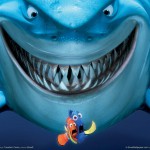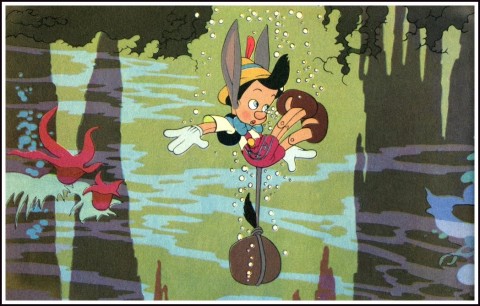
Saturday, September 15, 2012
If Cinema Siren had a dime for every time a perfectly down-to-earth average adult said Finding Nemo is one of their favorite movies, I might have a yacht as big as Steven Spielberg’s. The Siren knows animation. Alter ego Leslie Combemale owns a gallery that has specialized in animation and film art for 19 years.
When I say “I know Nemo,” I mean I’ve seen it at least 20 times, and have met and spoken to Pixar animators and directors many times. I remember the way they spoke of Finding Nemo in hushed tones in 2003, just before it was released. The artists knew they had something spectacular. It is one of the only times I can ever remember when positive expectation and pride was universal.
Many fans and critics believe this wonderful film to be the best representation of Pixar’s mastery and constant further expansion of computer animation. It is a testament to Finding Nemo that not only does the story hold up, but in an age when new invention in all things computer-related is a constant, the animation still looks fresh and innovative, even in 2D.
The timeless tale — an overprotective father learning to let go, and a child beginning to trust and find himself — never goes out of style, and continues to resonate with a wide audience.
In Walt Disney films, there are few classic examples of father-son relationships or father figures. Pinocchio in 1940, 101 Dalmatians in 1960, and The Jungle Book in 1967. Interestingly, like Finding Nemo, these three movies all represent major landmarks in Disney history.
Pinocchio made elaborate use of the multiplane camera, which resulted in the gorgeous scenes both underwater and in the Italian village. In 101 Dalmatians, it was the first time xerography was used for an entire film. Xerography uses the original drawings and copies them from above with a machine that transfers it to the cels, which allows for a greater integrity of the original artists’ drawings.
There were so many spots on the dogs, if they had hand-inked all the cels (as they did before the invention of xerography), the spots would all have been very hard to keep track of and ink accurately. It would have taken forever, or perhaps even the movie wouldn’t have been done at all. Incidentally, it was not very well reviewed at its release, and has arguably the worst song in Disney history (Dalmatian Plantation).
The Jungle Book was the first time Disney used voice artists to shape and influence the animated characters (most notably Louis Prima for King Louie) and was the last movie Walt was extensively involved in before he died. All these movies are fan favorites. They are also unique in Disney animation for featuring a storyline where the relationship between a father and child or children is the focus.
Finding Nemo, however, is without question the film with the most well-developed characters and integrated storyline in animation that shows the father-son relationship. At its release, there was deserved and universal praise for its realistic portrayal of a parent letting go as portrayed through animation. It is no less poignant or powerful nearly 10 years on.
Why, though, should we go see it in 3D, when we can all hunker down in our basements and see it for the umpteenth time on our own big screens? Because Finding Nemo and 3D are like — hmmm — Jack and Sally in The Nightmare Before Christmas. They are simply meant to be. Even people who have never liked 3D could be converted by the look of this movie. It is as if it always was designed to be seen this way.
The sequence of the sharks in the submarine with Marlin and Dory, for example, is particularly sublime. In the way it pulls together the humor, dramatic tension and now adds a dimension of more depth and texture (both of which were very much the focus in the making of the original film), it allows for even more connection between the audience members and the characters on screen.
The 3D adds to the excitement. Throughout the film, in both the tender and intense moments, the 3D feels a bit like the gorgeous wrapping paper on a birthday present. It just makes the whole experience of the film opening up and surprising you more complete.
Obviously, if you or your children haven’t seen Finding Nemo in the first place, this is a great opportunity to do so, assuming you have any interest in animation or film.
Also playing with Finding Nemo is Partysaurus Rex, third in a series of Toy Story-based shorts, and this one is directed by Pixar’s Mark Walsh. It is another example of Pixar creating a short so good it is worth the price of admission. The story is about T Rex feeling left out and making friends in the bathtub by inadvertently putting on a rave. It is hilarious and filled with in jokes club kids will enjoy, while at the same time appealing to older Toy Story fans who can relate to being seen as a stick in the mud, and wanting to change people’s perception of them and just have fun!
We are all going into election overload, no? Time for a break and some fun! If you are looking for that fun, and nostalgia mixed with the new shiny 3D, this is the perfect time to go check out Partysaurus Rex and Finding Nemo 3D.
Remember, you get to hear Willem Dafoe as a jaded fish and enjoy the mellow of the dad-son turtle team Crush and Squirt? Dude! That alone is reason enough to go.










